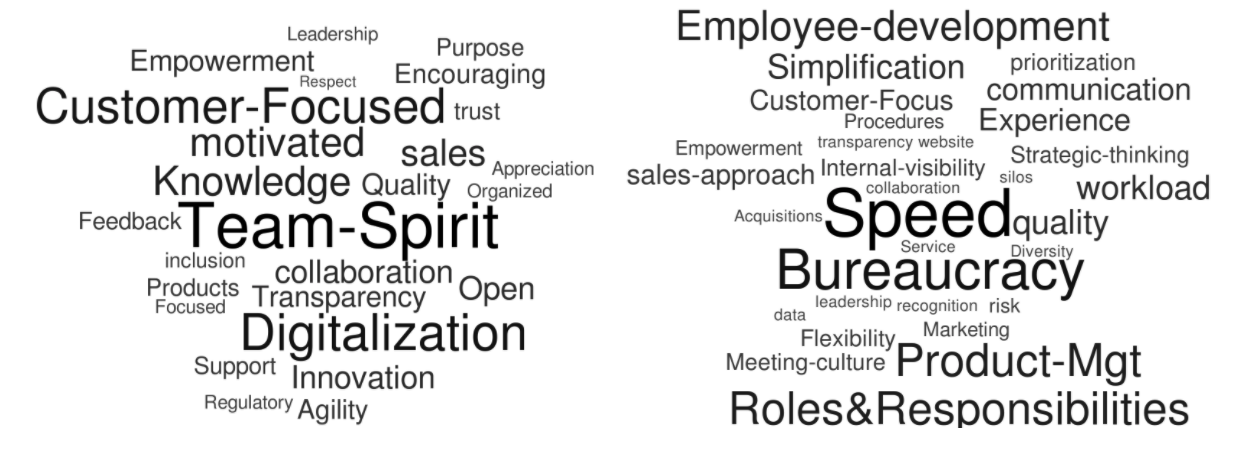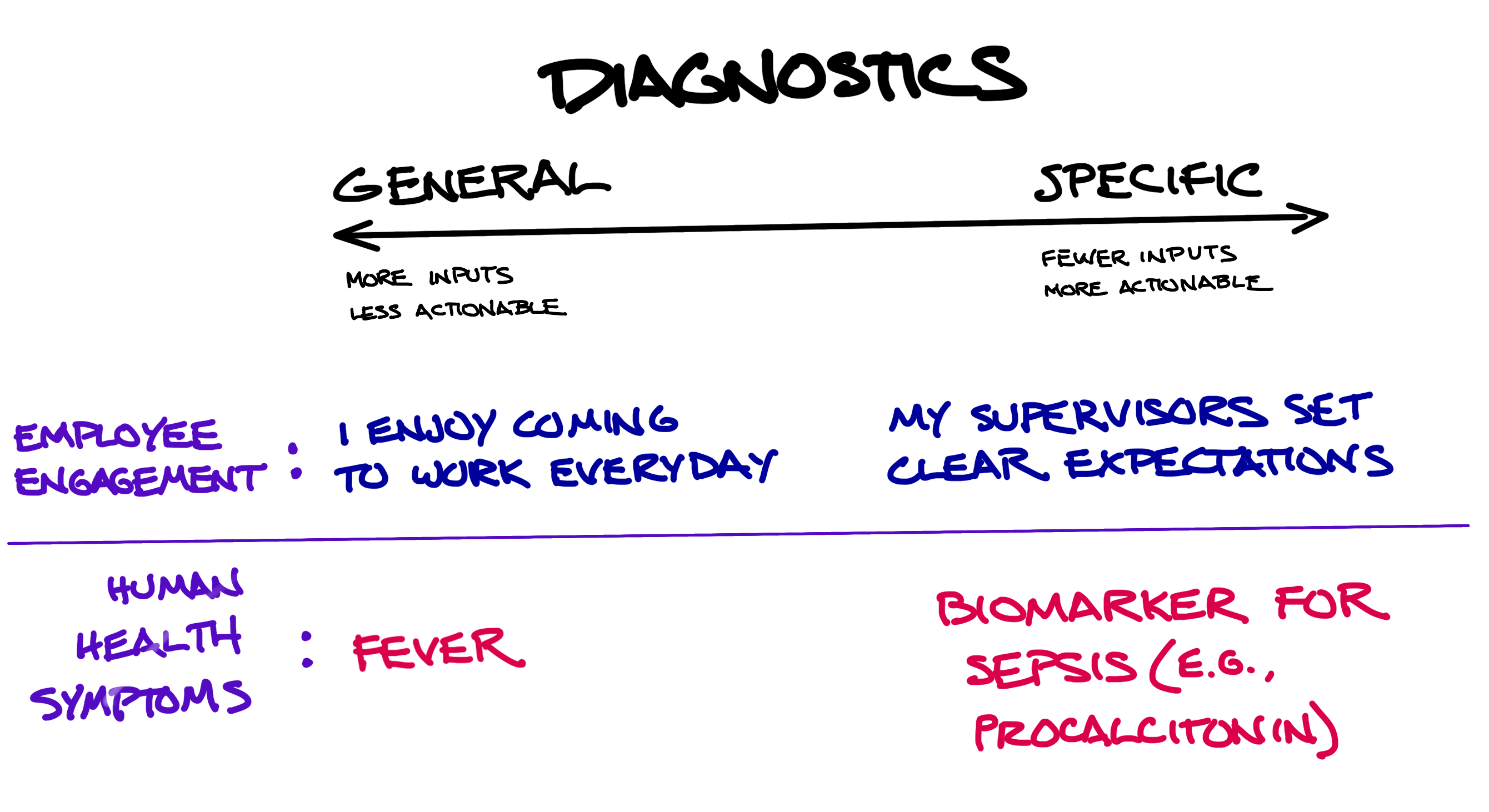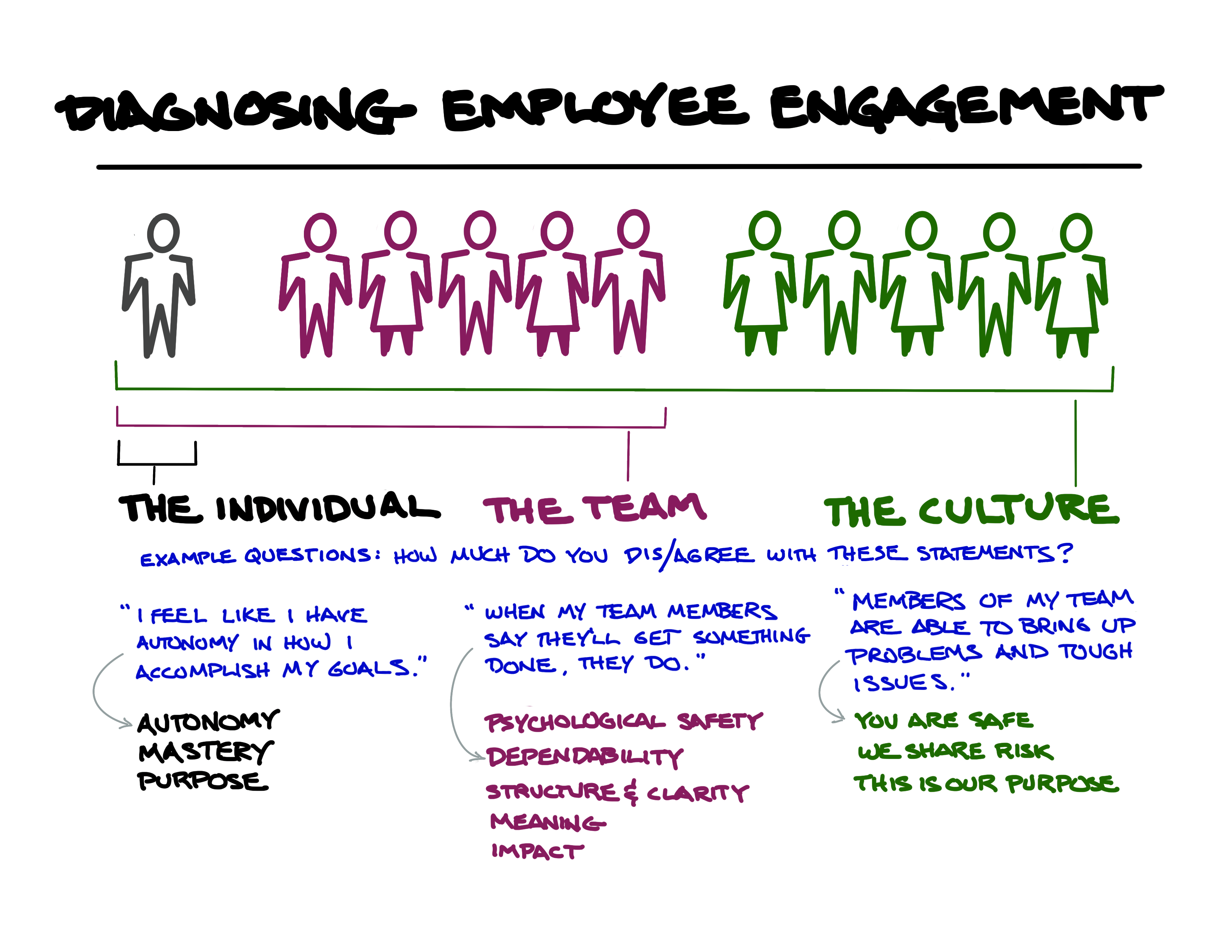Diagnosing Issues with Employee Engagement, Alignment, and Retention
By David Chapin

SUMMARY
VOLUME 13
, NUMER 1
Are you facing issues with employee engagement, alignment and retention? We’ve got some thoughts on the matter and a few ways to explore further. If you only have a few minutes, watch the video. Or you can read the following summary for an overview of this important topic. If you want to dive deeper, please read the entire whitepaper.
Treating employee engagement issues
Based on some of the writing I’ve published recently about employee engagement, alignment and retention, I received an email recently directing my attention to a list entitled “101 Employee Retention Strategies.” These types of lists are pretty common; if you’re interested, your favorite search engine will serve up many examples.
Even if this is a topic you care about, you probably won’t find your interest rewarded. Looking through this particular list, I found recommendations such as: host scavenger hunts, “to introduce fun and adventurous ways of finding some amazing gifts;” issuing a hydration challenge, “to keep a check on water intake;” and even hosting a recess every day, “to help your employees break out from a consistent schedule.”
The truth is that many of these lists are nothing more than a collection of possible treatments and “ingredients”
I’m sure that many of these strategies might possibly work, but the circumstances would have to be just right, wouldn’t they? The truth is that many of these lists are nothing more than a collection of possible treatments and “ingredients”—the equivalent of a complete list of approved drugs or a pharmacopeia. The point being: while a list of myriad possible treatments might be useful in some circumstances, it isn’t very useful for addressing the issues of a particular patient. Nor, in our case, is a list of myriad possible strategies useful for addressing the engagement, alignment, or retention issues of a particular group of employees. If you have been treated unfairly at work, you may consult an expert in employment law Schaumburg to know which legal actions you can take.
Why? Well, for one, the list could be incomplete. After all, a typical list of approved drugs doesn’t include all possible treatment modalities, such as surgery, physical therapy, or alternate therapies such as acupuncture, meditation, yoga, etc. And while that’s important, what’s even more significant is that this type of list is designed to answer the wrong question.
A list of drugs answers the question: What are all the approved drugs available to me? But to someone with an illness, knowing all the possible drugs that are on the market isn’t very helpful. If you are suffering from psoriasis, you don’t need a complete list of medications for ulcers, migraines and toenail fungus. If you’ve got an illness, the questions for which you really need answers are quite different. The important questions are:
- What is my condition, specifically?
- What are the symptoms?
- What are the underlying causes?
- What treatment is most efficacious?
- What are the possible side effects?
A list of drugs or a pharmacopeia isn’t designed to answer these questions.
Diagnosing employee engagement, retention, or alignment issues
If you have an employee engagement, retention, or alignment issue, you don’t need to start with a list of possible treatments; you must start with a clear, accurate diagnosis. I want to use this issue to explore ways to diagnose your employee engagement, alignment, and retention issues. Then, in the next issue, I’ll talk about how you can tune your treatments to address the specific issues you find during diagnosis.
Proper diagnosis starts with symptoms
What symptoms would appear in your organization suggesting you had a problem with employee engagement, alignment or retention? As part of our diagnostic process, we ask employees two questions that never fail to reveal some symptoms—as well as highlight things that are working well. Figure 1 shows the answers for these two questions: “What is going well at your organization?” and “What needs improvement at your organization?”
Figure 1: Asking open-ended questions such as: “What is going well at your organization?” (shown on the left) and “What needs improvement at your organization?” is a quick way to get a general sense of possible symptoms related to employee engagement, alignment, and retention. What symptoms do you see in these two word-clouds? It’s interesting to note that some answers appear in both images, e.g., Customer-focus, Leadership, and Empowerment.
Based on questions like these, here is a small list of common symptoms we’ve encountered over the years: increases in employee turnover, decreases in quality, delays in deliverables, friction among employees (including complaints about teammates), problems with attendance (arriving late, leaving early, excessive vacation or sick leave), slow response to emails, etc. This list is not complete; I’m sure you can come up with additional symptoms. In general, these can be roughly categorized into data, actions, and words, as in figure 2.
Figure 2. Symptoms of issues with employee engagement, alignment and retention can be divided into three categories: data, actions and words.
Symptoms must be interpreted carefully
The presence of some or all of these symptoms by themselves is not conclusive. Many of these could indicate the presence of other, unrelated problems. For example, a poor-fit employee that joined the team due to a bad hiring decision could also be the source of many of the symptoms above. While a secondary effect of this poor hiring decision might be employee engagement issues among teammates, the primary cause is the hiring decision itself.
To monitor these symptoms, most organizations have an active monitoring program in place. This allows them to take a snapshot as well as monitor changing trends over time. The larger organizations typically conduct a semi-annual or annual survey; smaller organizations typically rely on less formal methods, such as “keeping our eyes and ears open.” These monitoring programs have mixed results. A 2020 study conducted by the Human Capital Institute found that almost three-quarters of US companies solicit feedback from employees through surveys, polls, emails, or chat boards. However, this doesn’t often lead to meaningful changes; 41% of organizations don’t take any action at all, and 26% rate themselves as “not very successful.”.
Diagnosing your employee engagement, alignment or employee engagement challenges
Just as in human clinical practice, a wide range of diagnostic tools is available for issues related to engagement, alignment, and retention. These can be loosely categorized as indirect or direct. Direct diagnostic methods involve communication with employees through either anonymous means—e.g., surveys or even old-fashioned “suggestion boxes”—or non-anonymous means such as focus groups or one-on-one conversations. Indirect diagnostic methods involve looking for issues without talking directly to employees; examples include scanning the company reviews on GlassDoor.com, monitoring social media, or tracking metrics like employee turnover rate.
If you are considering direct methods, there are many employee survey tools available; most use pre-packaged questions. The topics probed by these questions are often similar, even though the specific wording can vary from survey to survey. I’ll list a few common questions below. As you read these, ask yourself: how actionable would the results be? To put this another way, if you received uniformly poor marks from your employees on a particular question, how clear would your course of action be?
Typical diagnostic questions—how actionable are they?
Here are a few typical questions.
How much do you agree with the following statements (strongly disagree to strongly agree)?
- I can receive good, relevant training that helps me improve my skills and capabilities.
- My supervisors set clear expectations and keep me well informed.
- When my team members say they’ll get something done, they do.
- I would refer my friends and family to work at this company.
- I enjoy coming to work every day.
Which of these questions are the most actionable? For example, “My leaders keep me well informed” is very specific. If you received unequivocally poor marks here, the course of action would be pretty clear: you’d bring up the topic with the relevant supervisors. This question is highly actionable because it asks about very specific symptoms, so the treatment (the levers to adjust how informed employees are) is pretty obvious and focused.
Other questions are much less actionable. For example, what action would you take if you received poor marks for: “I enjoy coming to work every day.” There’s no single lever you can pull to adjust “employee-overall-daily-coming-to-work-enjoyment.” That’s because there are many different inputs that might contribute to any one employee enjoying coming to work, including such diverse factors as relationships with coworkers or supervisors, corporate culture, compensation, a feeling of purpose, a sense of autonomy, respect, etc. And the balance of those inputs is going to be different for each employee.
Keep in mind, though, that while some diagnostic questions tend to be less actionable than others, this doesn’t mean they are not important.
A spectrum of diagnostic questions
I’d like to draw a distinction between questions that have fewer, more specific inputs and those questions that have more, and more general, inputs. An analogy to human health works well here. A patient’s temperature is a general symptom of health; there can be many causes of fever. In contrast, measuring the level of the biomarker procalcitonin can indicate with great accuracy the presence of sepsis, one of the many specific causes of fever. See figure 4.
Figure 4. Diagnostic questions come in many varieties. Some give a sense of the general engagement and alignment of employees; these tend to have multiple inputs and can be markers of many possible symptoms. Others give a sense of specific symptoms; these tend to have fewer, more specific inputs. Your diagnostic efforts need to include both types of questions.
Both types of questions are important. And of course, you’re not limited to these two distinct types; there is an entire spectrum of questions, from specific to general, that can be asked. At one end of the spectrum is the question: “How much do you agree with the following statement: My supervisors set clear expectations and keep me well informed. A much more general question would be: How much do you agree with the following statement: I enjoy coming to work every day. And the following question would be even more general: How much do you agree with the following statement: I would refer my friends and family to work at this company. You see, most people would have to enjoy coming to work every day before they would recommend to their friends and family that they come to work at the same company.
Which diagnostic questions should we ask?
There are thousands of possible diagnostic tests one could run on a human patient; no doctor would run every possible test. How does a trained professional decide what diagnostics to run? I’m not a doctor, nor do I play one on TV, so my answer doesn’t describe the specific decision tree that a trained doctor would use. But they would use a decision tree, wouldn’t they? This decision tree is based on a model of human health.
Similarly, there are thousands of possible diagnostic questions one could ask to gain insight into employee engagement, alignment, and retention. But no employee has time to answer thousands of questions, and it would be malpractice to ask that many. We need some guiding principles about which questions to include and which to exclude—that is, we need a model.
At Forma, we use a specific model of employee engagement, alignment, and retention to guide our selection of diagnostic questions; this model is based on reams of peer-reviewed scientific research. I’ve discussed this model before. As a refresher, I’ll provide an overview of this model and then show how it can guide the selection of your diagnostic questions.
A model of employee engagement, alignment, and retention
Employee engagement and alignment is influenced by three main areas: individual motivation, team performance, and corporate culture. There is significant and replicable science behind these three areas, which has uncovered the key components of each. See figure 5.
Figure 5. There are three main areas that affect employee engagement, alignment and retention: individual motivation, team performance and corporate culture. Peer-reviewed research has uncovered the many factors that drive performance in each. There are three factors which influence individual motivation, as discussed by Dan Pink in his book Drive, the surprising truth about what motivates us. There are five factors which must be present for a team to exhibit high performance, as uncovered through extensive research by Google. And there are three factors that must be present in effective corporate culture, as discussed by Daniel Coyle in his book The Culture Code; The Secrets of Highly Successful Groups. You can see from this figure that there is overlap and similarity among many of these areas.
Each of these areas can be probed by specific questions. A few of the questions we use are shown in figure 6.
Figure 6. A few questions are shown here. Forma uses dozens of questions to probe the 11 areas related to individual motivation, team performance and corporate culture shown here.
Running these diagnostics allows us to pinpoint the areas that need help.
Match the proper treatment to the diagnosis
Once you’ve diagnosed your condition, you can develop a treatment plan. Just as with diagnosis, treatment requires a model. This model will be linked to, but separate from, your diagnostic model, and we’ll talk more about that next time.
Obviously, the treatments you use will depend upon your diagnostic findings. The treatment you’d employ for issues relating to Mastery (a component of the Individual section of the employee engagement model shown in figure 5) would be very different than the treatments you would implement for issues relating to Dependability (a component of the Team section).
Our work with clients has shown that when we pinpoint their condition with the proper diagnostics, we can then successfully treat the condition, and thereby improve individual motivation, team performance, and organizational culture. In the next issue, I’ll describe some specific actions you can take to tune the treatments you use, depending on what you’ve found when running diagnostics.
As always, let us know your feedback.
The Marketing of Science is published by Forma Life Science Marketing approximately ten times per year. To subscribe to this free publication, email us at info@formalifesciencemarketing.com.
David Chapin is author of the book “The Marketing of Science: Making the Complex Compelling,” available now from Rockbench Press and on Amazon. He was named Best Consultant in the inaugural 2013 BDO Triangle Life Science Awards. David serves on the board of NCBio.
David has a Bachelor’s degree in Physics from Swarthmore College and a Master’s degree in Design from NC State University. He is the named inventor on more than forty patents in the US and abroad. His work has been recognized by AIGA, and featured in publications such as the Harvard Business Review, ID magazine, Print magazine, Design News magazine and Medical Marketing and Media. David has authored articles published by Life Science Leader, Impact, and PharmaExec magazines and MedAd News. He has taught at the Kenan-Flagler Business School at UNC-Chapel Hill and at the College of Design at NC State University. He has lectured and presented to numerous groups about various topics in marketing.
Forma Life Science Marketing is a leading marketing firm for life science, companies. Forma works with life science organizations to increase marketing effectiveness and drive revenue, differentiate organizations, focus their messages and align their employee teams. Forma distills and communicates complex messages into compelling communications; we make the complex compelling.
© 2024 Forma Life Science Marketing, Inc. All rights reserved. No part of this document may be reproduced or transmitted without obtaining written permission from Forma Life Science Marketing.






